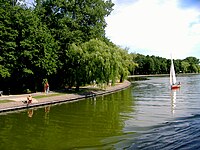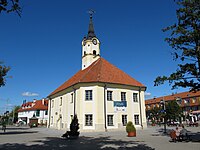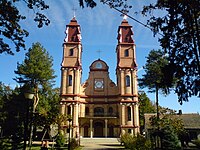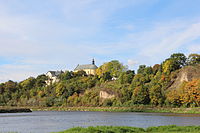Podlachia
This article needs additional citations for verification. (June 2011) |
Podlachia
Podlasie | |
|---|---|
| |
|
UTC+2 (CEST ) |

Podlachia,
Names and etymology
The region is called Podlasie, Podlasko or Podlasze in
There are two hypotheses regarding the origin of the name of the region. According to the first one, the name is derived from the Polish word las ("forest"), and means "near the forest".[3] A common folk derivation is from the Proto-Slavic word les or las meaning "forest", i.e., it is "by the wood(s)" or an "area of forests", making Podlachia close in meaning to adjacent Polesia. The theory has been questioned, as it does not properly take into consideration the vowel shifts "a" > "e" > "i" in various Slavic languages (in fact, it mixes vowels from different languages).
According to the second theory, the name is derived from the word liakh (or lach,
Geography

Podlachia is located along the middle stretch of the
Traditional capital of Podlachia is Drohiczyn that lies into northern and southern parts. The former is included in the modern-day Podlaskie Voivodeship with its capital at Białystok (the historical boundary goes exactly through the city). Sometimes, Siedlce has been considered the capital of the region.
History

Podlaskie Voivodeship is a multicultural and multi-religious region. It is the region where people's identity has been shaped throughout history by both the Orthodox and Roman Catholic churches, and since the Reformation, also by Evangelical churches. Until today, Podlaskie has been considered Poland's most culturally diverse region.[4] Throughout its early history, Podlachia was inhabited by various tribes of different ethnic roots. In the 9th and 10th centuries, the area was inhabited by East Slavic tribes, mostly by Drevlians, with settlements of Dregoviches to the north beyond the Narew River and likely Dulebes to the south,[3] although a Masovian-like population had also been present.[5]
In the 14th century the area was annexed by the
Partition and Napoleonic Wars
Following the 1795 Third Partition of Poland which brought an end to Poland-Lithuania, the former Podlachia Voivodeship was divided between the Kingdom of Prussia and the Habsburg monarchy (Austrian Empire from 1804), with the Bug forming the border between them. Part of Podlachia's eastern border became the boundary between Prussia and the Russian Empire. Within Prussia the Podlachian territory was organised as part of the Białystok Department of New East Prussia, which also included parts of the former Mazovian and Trakai Voivodeships; the Habsburg portion lay mostly within the Siedlce Kreis of West Galicia (Galicia and Lodomeria from 1803).
In 1807, by the
Russian rule
At the end of the Napoleonic wars in 1815, the
In 1842 the Belostok Oblast was dissolved and merged into Grodno Governorate,[3] and the Drohiczyn Uyezd was merged into Bielsk Uyezd. In 1844 the Podlachian Governorate was merged into the Lublin Governorate.
In the 19th century the region was a stronghold of Polish resistance against Russian rule. Stanisław Brzóska, the last partisan of the January Uprising, operated there until 1865. He was hanged publicly by the Russians in Sokołów Podlaski in May 1865. As a result of the uprising, in 1867 Congress Poland was formally absorbed into Russia as the Vistula Land (Privislinsky Krai), although the Kingdom still nominally existed. The Podlachian Governorate was also restored under the name Siedlce Governorate, and the Augustów Governorate was split between the Łomża and Suwałki Governorates; Augustów itself went to Suwałki Governorate while the rest of the Podlachian territory went to the Łomża Governorate.
According to
In 1912 Siedlce Governorate was once again abolished and divided between the
World War I to present
During World War I the area was occupied by the German Empire, with most of the Vistula Land falling under the Government General of Warsaw (later the Central Powers puppet Kingdom of Poland) while the areas further east, including Białystok and the Suwałki Governorate, fell under Ober Ost.
In the aftermath of World War I and the Russian Revolution, parts of the region, particularly Białystok, were contested by several states but ultimately became part of the Second Polish Republic following the Polish–Soviet War. During the interwar period the northern part fell entirely within the Białystok Voivodeship while the southern part belonged to the Lublin Voivodeship; the April 1938 reforms transferred Węgrów and Sokołów from Lublin to the Warsaw Voivodeship.
In 1939 Poland was
In 1999 the modern Podlaskie Voivodeship was established which encompasses the northern part of historic Podlachia, including Białystok and Drohiczyn, as well as surrounding areas, including Łomża and Suwałki. Its southern border lies along the Bug.
Demographics
Ethnic situation
While today Podlachia is mostly inhabited by
Orthodox autochthonous inhabitants are known as
Until the 19th century, Podlachia was populated by the Polish-speaking
In the 19th century, the inhabitants of Podlachia were under the rule of the
Podlachia is also the cultural center of Poland's small Tatar minority as well.[citation needed] After the annexation of eastern Poland into the Soviet Union following World War II, Poland was left with only 2 Tatar villages, Bohoniki and Kruszyniany (both outside the historical borders of Podlachia). Some Tatars from the territories annexed to the USSR have been repatriated to Poland and clustered in cities, particularly Białystok.[citation needed] In 1925 the Muslim Religious Union (Muzułmański Związek Religijny) was formed in Białystok. In 1992, the Union of Tatars of the Republic of Poland (Związek Tatarów Rzeczypospolitej Polskiej) with autonomous branches in Białystok and Gdańsk began operating.[citation needed]
Language
The dominant language in Podlaskie Voivodeship is Polish.[17] Autochthonous inhabitants speak a Podlachian variety. Many linguists relate them to the Ukrainian language.[18][19] Linguists have been exploring them since 19th century, when they were also known as Siedlce dialects (because of the name of Siedlce Governorate, where the dialects were mostly investigated).[20] There is a problem if they should be considered as part of west Polisian dialects subgroup or as a separate subgroup of northern dialectal group of the Ukrainian language.[21] In the Northern Podlachia Podlachian subdialects are also often considered to be Belarusian dialects[22][20] or sometimes Ruthenian dialects.[23]
Since the locals are known as
Cities and towns
| City | Population (2015–16)[25] | Pop. (1931) | Administrative division | Additional information | |
|---|---|---|---|---|---|
| 1. | Brest | 340,141 | 48,431 | Brest Region | Part of Podlachia until 1566, after 1566 it is rather considered part of royal city of Poland.
|
| 2. | Białystok | 295,981 | 91,335 | Podlaskie Voivodeship | Former Branicki family .
|
| 3. | Biała Podlaska | 57,414 | 17,549 | Lublin Voivodeship | Part of Podlachia until 1566, after 1566 it was rather considered part of Polesia, nowadays the area is referred to as Southern Podlachia; former private town of the Radziwiłł family. |
| 4. | Kobryn | 52,655 | 10,101 | Brest Region | Part of Podlachia until 1566, after 1566 it is rather considered part of Polesia. |
| 5. | Augustów | 30,449 | 12,147 | Podlaskie Voivodeship | Former royal city of Poland. |
| 6. | Byaroza | 29,408 | 4,521 | Brest Region | Area was part of Podlachia until 1566, after 1566 it is rather considered part of Polesia. |
| 7. | Bielsk Podlaski | 26,336 | 7,029 | Podlaskie Voivodeship | Former royal city of Poland, capital of Bielsk Land. |
| 8. | Hajnówka | 21,559 | Podlaskie Voivodeship | ||
| 9. | Sokołów Podlaski | 18,720 | 9,901 | Masovian Voivodeship | Former private town of the Kiszka and Radziwiłł families.
|
| 10. | Pruzhany | 18,459 | 8,013 | Brest Region | Part of Podlachia until 1566, after 1566 it is rather considered part of Polesia. |
| 11. | Międzyrzec Podlaski | 17,117 | 16,837 | Lublin Voivodeship | Part of Podlachia until 1574, after 1574 it was rather considered part of Polesia, nowadays the area is referred to as Southern Podlachia, former private town. |
| 12. | Łapy | 16,005 | 6,674 | Podlaskie Voivodeship | |
| 13. | Siemiatycze | 14,766 | 6,816 | Podlaskie Voivodeship | Former private town of the Jabłonowski family .
|
| 14. | Włodawa | 13,643 | 8,519 | Lublin Voivodeship | Part of Podlachia until 1566, after 1566 it was rather considered part of Polesia, nowadays the area is referred to as Southern Podlasie; former private town. |
| 15. | Zhabinka | 13,357 | Brest Region | Area was part of Podlachia until 1566, after 1566 it is rather considered part of Polesia. | |
| 16. | Węgrów | 12,796 | 9,416 | Masovian Voivodeship | Former private town of the Radziwiłł family, westernmost town of Podlachia. |
| 17. | Malaryta | 11,823 | Brest Region | Area was part of Podlachia until 1566, after 1566 it is rather considered part of Polesia. | |
| 18. | Mońki | 10,352 | Podlaskie Voivodeship | ||
| 19. | Wysokie Mazowieckie | 9,503 | 3,977 | Podlaskie Voivodeship | Former private town. |
| 20. | Kamyenyets | 8,405 | 3,001 | Brest Region | Part of Podlachia until 1566, after 1566 it is rather considered part of Polesia. |
| 21. | Łosice | 7,099 | 5,026 | Masovian Voivodeship | Former royal city of Poland. |
| 22. | Terespol | 5,815 | 2,308 | Lublin Voivodeship | Part of Podlachia until 1566, after 1566 it was rather considered part of Polesia, nowadays the area is referred to as Southern Podlachia; former private town. |
| 23. | Choroszcz | 5,782 | 2,905 | Podlaskie Voivodeship | Former private town of the Branicki family. |
| 24. | Vysokaye | 5,164 | 2,739 | Brest Region | Area was part of Podlachia until 1566, after 1566 it is rather considered part of Polesia. |
| 25. | Ciechanowiec | 4,840 | 4,029 | Podlaskie Voivodeship | Former private town. |
| 26. | Brańsk | 3,867 | 4,204 | Podlaskie Voivodeship | Former royal city of Poland. |
| 27. | Knyszyn | 2,850 | 4,123 | Podlaskie Voivodeship | Former royal city of Poland, royal residence of King Sigismund II Augustus. |
| 28. | Szepietowo | 2,282 | Podlaskie Voivodeship | Youngest town of Podlachia. | |
| 29. | Kosów Lacki | 2,187 | Masovian Voivodeship | ||
| 30. | Drohiczyn | 2,125 | 2,309 | Podlaskie Voivodeship | Historical capital of Podlachia, former royal city of Poland, capital of Drohiczyn Land. |
| 31. | Tykocin | 2,014 | 3,290 | Podlaskie Voivodeship | |
| 32. | Goniądz | 1,900 | 3,449 | Podlaskie Voivodeship | Former royal city of Poland. |
| 33. | Mordy | 1,819 | 3,287 | Masovian Voivodeship | Former private town of the Radziwiłł and Ciecierski families. |
| 34. | Rajgród | 1,626 | 2,432 | Podlaskie Voivodeship | Former royal city of Poland. |
| 35. | Kleszczele | 1,345 | 2,029 | Podlaskie Voivodeship | Former royal city of Poland. |
| 36. | Suraż | 1,008 | 1,379 | Podlaskie Voivodeship | Former royal city of Poland. |
Gallery
-
Branicki Palace in Białystok, the largest city of proper Podlachia
-
The formerroyal city of Augustówis the northernmost city of Podlachia and a popular summer tourist destination
-
Baroque town hall in Bielsk Podlaski, a former royal city of Poland and capital of Bielsk Land
-
primaeval forestin Europe
-
Branicki Palace in Choroszcz
-
17th-century Church of the Assumption in Siemiatycze
-
Drohiczyn and Bug river
-
Tykocin Synagogue. Tykocin is one of the best preserved shtetls in Poland. The main synagogue dates back to the 17th century.
-
Grabarka
References
- ^ Paul Robert Magocsi. Historical Atlas of Central Europe: From the early fifth century to the present. Thames & Hudson, 2002.
- William Fiddian Reddaway. The Cambridge History of Poland: Volume 2. 1971.
- Zigmantas Kiaupa. The History of Lithuania. Baltos Lankos, 2005. p.52.
- Zenon E. Kohut, Bohdan Y. Nebesio, Myroslav Yurkevich. Historical Dictionary of Ukraine. Scarecrow Press, 2005.
- Jerzy Kłoczowski. A History of Polish Christianity. Cambridge University Press, 2000, p.268. - ISBN 978-1-00-128802-4.
- The Gate of Podlasie
- Podlasie Archived 2013-12-11 at the Wayback Machine
- Introducing Mazovia & Podlasie
- Podlasie24
- Podlasie Jazz Festival - ^ Volodymyr Kubijovyč. "Podlachia". Encyclopedia of Ukraine. Retrieved 23 February 2020.
- ^ Górczyk, Wojciech Jerzy (January 2020). "The Former Reformati Order's Monasteries Route": 22.
{{cite journal}}: Cite journal requires|journal=(help) - ISBN 83-87026-70-0.
- ^ "Первая всеобщая перепись населения Российской Империи 1897 г. Распределение населения по родному языку, губерниям и областям". www.demoscope.ru (in Russian). Демоскоп Weekly. Retrieved 22 February 2020.
- ^ "Первая всеобщая перепись населения Российской Империи 1897 г. Распределение населения по родному языку и уездам 50 губерний Европейской России". www.demoscope.ru (in Russian). Демоскоп Weekly. Retrieved 22 February 2020.
- ^ "The First General Census of the Russian Empire of 1897. Breakdown of population by mother tongue and districts* in 50 Governorates of the European Russia". www.demoscope.ru. Demoscope Weekly. Retrieved 2023-06-14.
- ^ Barwiński 2005, p. 1.
- ^ Barwiński 2005, p. 9.
- ^ Barwiński 2005, p. 6, 18.
- ^ Arkushyn 2019, p. 116-117.
- ^ Barwiński 2005, p. 7.
- ^ Barwiński 2005, p. 12.
- ^ a b c Arkushyn 2019, p. 118.
- ^ Barwiński 2005, p. 8, 18.
- ^ Barwiński 2005, p. 14.
- ^ Arkushyn 2019, p. 115-116.
- ^ Barwiński 2005, p. 17-18.
- ^ a b Lesiv 1997, p. 291.
- ^ Arkushyn 2019, p. 116.
- ^ Arkushyn 2019, p. 115.
- ^ Lesiv 1997, p. 368.
- ^ Lesiv 1997, p. 283.
- ^ "Lista miast w Polsce (Spis miast, mapa miast, liczba ludności, powierzchnia, wyszukiwarka)".
Sources
- Arkushyn, H. L. (2019). "Хахлацька мова на Підляшші" [Khakhatska language in Podlachia] (PDF). Українська мова (in Ukrainian) (1). Луцьк: 115–125. ISSN 1682-3540. Retrieved 23 February 2020.
- Barwiński, Marek (2005). "Struktura narodowościowa i językowa mieszkańców południowo-wschodniej części województwa podlaskiego – porównanie wyników badań terenowych i Narodowego Spisu Powszechnego". Pogranicze (in Polish). Wydawnictwo Uniwersytetu w Białymstoku: 67–84. ISSN 1230-2392.
- Górczyk, Wojciech Jerzy (2020), The Former Reformati Order’s Monasteries Route Węgrów.
- Górczyk, Wojciech Jerzy (2018), Reformaci w Węgrowie. Architektura kościoła i miejsce fundacji węgrowskiej na tle działalności fundacyjnej Krasińskich Drohiczyński Przeglad Naukowy. Drohiczyńskie Towarzystwo Naukowe: 307–326.
- Lesiv, Mykhailo (1997). Українські говірки в Польщі [Ukrainian subdialects in Poland] (in Ukrainian). Український архів.















